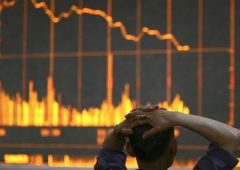The US Economy Outpaces Expectations in the Second Quarter
25.07.2024 16:47 1 min. read Alexander Stefanov
The Bureau of Economic Analysis's advance estimate revealed that the US gross domestic product (GDP) grew at an annualized rate of 2.8% in the second quarter, surpassing the 2% growth predicted by Bloomberg-surveyed economists.
This figure was also higher than the first quarter’s revised GDP growth of 1.4%.
The “core” Personal Consumption Expenditures index, which excludes food and energy, rose by 2.9% in the first quarter, exceeding estimates of 2.7% but down from the previous quarter’s 3.7% increase.
This data release comes as investors assess when the Federal Reserve might start cutting interest rates and whether the central bank can reduce inflation to its 2% target without triggering a significant economic downturn.
As of Thursday, markets had fully priced in a rate cut by the Fed by the end of its September meeting.
Neil Dutta, head of economic research at Renaissance Macro, noted that the data supports the idea that the Fed can afford to wait. “With private domestic demand growing solidly, there is no urgency for the Fed to act quickly. July remains a preparatory meeting for September,” Dutta wrote.
-
1
U.S. PCE Inflation Rises for First Time Since February, Fed Rate Cut Likely Delayed
27.06.2025 18:00 1 min. read -
2
Key U.S. Economic Events to Watch Next Week
06.07.2025 19:00 2 min. read -
3
Gold Beats U.S. Stock Market Over 25 Years, Even With Dividends Included
13.07.2025 15:00 1 min. read -
4
U.S. Announces Sweeping New Tariffs on 30+ Countries
12.07.2025 16:30 2 min. read -
5
US Inflation Heats Up in June, Fueling Uncertainty Around Fed Cuts
15.07.2025 16:15 2 min. read
US Inflation Heats Up in June, Fueling Uncertainty Around Fed Cuts
U.S. inflation accelerated in June, dealing a potential setback to expectations of imminent Federal Reserve rate cuts.
Gold Beats U.S. Stock Market Over 25 Years, Even With Dividends Included
In a surprising long-term performance shift, gold has officially outpaced the U.S. stock market over the past 25 years—dividends included.
U.S. Announces Sweeping New Tariffs on 30+ Countries
The United States has rolled out a broad set of new import tariffs this week, targeting over 30 countries and economic blocs in a sharp escalation of its trade protection measures, according to list from WatcherGuru.
Key U.S. Economic Events to Watch Next Week
After a week of record-setting gains in U.S. markets, investors are shifting focus to a quieter yet crucial stretch of macroeconomic developments.
-
1
U.S. PCE Inflation Rises for First Time Since February, Fed Rate Cut Likely Delayed
27.06.2025 18:00 1 min. read -
2
Key U.S. Economic Events to Watch Next Week
06.07.2025 19:00 2 min. read -
3
Gold Beats U.S. Stock Market Over 25 Years, Even With Dividends Included
13.07.2025 15:00 1 min. read -
4
U.S. Announces Sweeping New Tariffs on 30+ Countries
12.07.2025 16:30 2 min. read -
5
US Inflation Heats Up in June, Fueling Uncertainty Around Fed Cuts
15.07.2025 16:15 2 min. read


